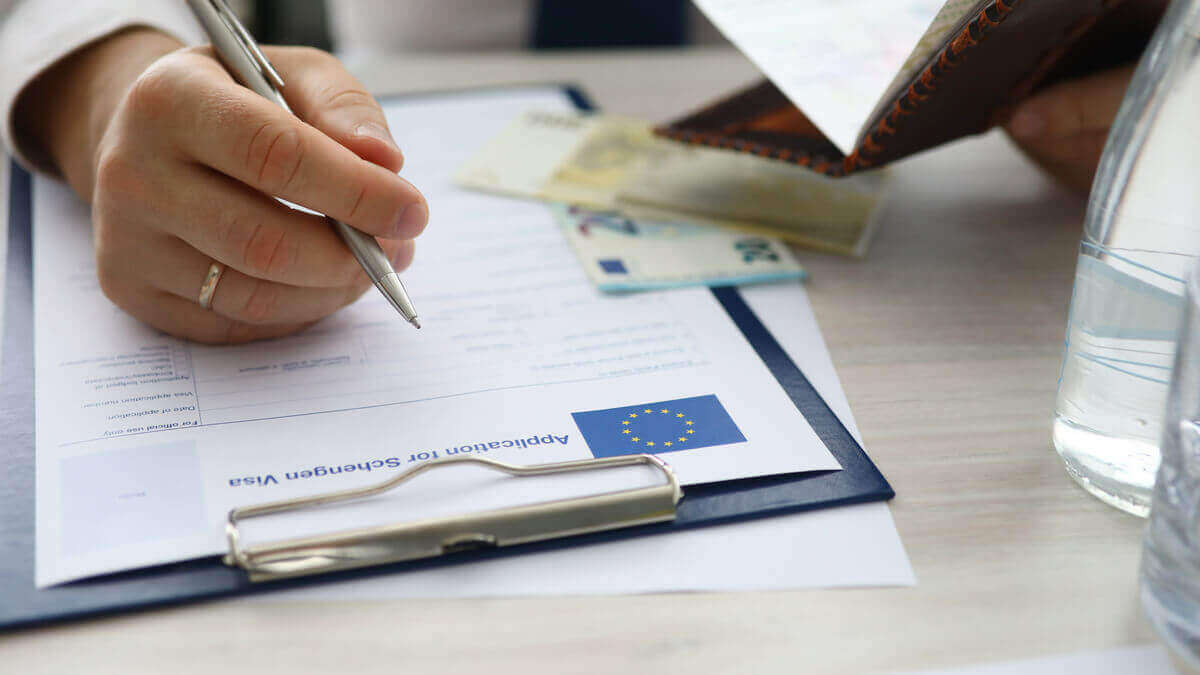The 90/180 Schengen rule: What it is and how it affects UK citizens
A clear guide for UK citizens on the 90/180 Schengen rule. Learn how to calculate your visa-free stay in Europe post-Brexit and avoid overstaying penalties.

Travelling from the UK to Europe's Schengen Area can be straightforward for some, but for others, it involves obtaining a visa. Some countries are much more likely to approve your application than others, and knowing which ones can save you time, stress, and money.
So, what is the easiest Schengen visa from the UK? Let's reveal which countries' visas are easiest to get based on 2024 statistics.
Schengen visa fees are usually charged in euros. Using a multi-currency card like the Wise card lets you pay in 40+ currencies and convert GBP to EUR at the mid-market rate, avoiding hefty bank exchange fees when paying for your visa or spending in Europe.
Learn more about the Wise card 💳
A Schengen visa is a short-term entry permit allowing non-EU nationals to visit countries in the Schengen Area for up to 90 days within a 180-day period.1
It's typically a sticker in your passport that lets you travel freely between all Schengen countries for tourism, business, or family visits.
If you plan to stay longer than 90 days or for purposes like work or study, you would need a different visa.
The Schengen Area is a zone of 27 European countries that have abolished internal border controls, essentially acting as one jurisdiction for travel purposes. It includes most EU countries plus a few non-EU states (Norway, Iceland, Switzerland, and Liechtenstein).2
Travelling within Schengen is visa-free once you're inside, but entry into the Schengen zone for outsiders usually requires going through border control (and having a valid visa if needed).

Citizens of certain non-EU countries must apply for a Schengen visa before visiting the Schengen Area. This generally includes nationals of most African, Asian, Middle Eastern, and South American countries that do not have a visa-free agreement with the EU.
On the other hand, visa-exempt nationalities (about 60 countries) can visit the Schengen short-term without a visa – this list includes the USA, Canada, Australia, New Zealand, and many others.
Since Brexit, British nationals are visa-exempt for short stays. That means if you're a UK passport holder travelling for up to 90 days in 180 days, you do not need a Schengen visa.1 For longer stays or work/study, UK citizens would need the appropriate national visa or permit.
If you live in the UK on an eVisa (previously a Biometric Residence Permit) and your nationality normally requires a Schengen visa, then you must apply for one to visit Europe. Your UK residency does not exempt you from Schengen visa requirements.
One of the first challenges in the visa process is securing an appointment at the embassy or visa application centre. In the UK, Schengen visa appointments can book up quickly, especially during peak travel seasons (like the summer holidays). This means you should schedule your visa appointment as early as possible.
You can apply as early as 6 months before your trip (minimum 15 days before travel). Most countries operate their visa submissions via third-party centres like VFS Global or TLScontact in the UK.
Check the official consulate website of your destination country, they'll direct you on how to book an appointment online.
Be mindful of processing times. Once you submit your application, the decision typically takes up to 15 calendar days in normal cases. However, it can take longer during busy periods or if additional documents are needed.

When applying for a visa, it helps to know which destinations are stricter. Some Schengen countries have higher refusal rates, often due to strict screening or high demand.
According to 2024 data, Malta had the highest rejection rate, with about 38.5% of Schengen visa applications denied.3 This Mediterranean microstate is popular but has limited processing capacity and tends to scrutinise applications closely.
The next toughest was Estonia, with a 27.2% rejection rate in 2024. Although Estonia receives fewer applications, its consulates are known to be very thorough (especially for first-time travellers with weaker financial or itinerary documentation).
Belgium was also among the most difficult, rejecting about 24.6% of visa requests – possibly due to high volumes of applications in Brussels (a hub for EU and NATO) and strict checks for complete paperwork.
Many Schengen countries approve the vast majority of visa applications.
Here are the top 10 countries with the lowest visa rejection rates based on the latest data.
Each of these countries had a well above the global average approval rate (14.8%), making them "easier" options if you have a choice of where to apply.
Iceland is consistently the most visa-friendly Schengen country. In 2024, it received over 35,000 visa applications and rejected only 6.6% of them.4
The country likely benefits from efficient processing and the fact that many applicants are well-prepared tourists. If you apply for an Icelandic Schengen visa with all your documents in order, your chances of approval are extremely high.
Bulgaria has quickly become one of the easiest places to get a Schengen visa. Data shows Bulgaria's rejection rate was around 9.4% in 2024.4 In that year, Bulgaria processed about 122,000 applications and denied roughly 12,000.
If you plan to visit Bulgaria (or use it as your main Schengen entry point), you're likely to get a positive outcome as long as you meet the requirements.
Romania also had an approx. 9.4% visa rejection rate in 2024.4
Romania's process is known to be efficient and relatively fast, possibly because they are keen to facilitate tourism and build trust as a new Schengen participant.
With a 9.9% rejection rate in 2024,4 Slovenia is one of the top easy-visa countries. This Central European nation has a straightforward visa process and isn't overwhelmed by demand.
It had a low-volume year, with only about 14,000 applications received, which may contribute to the high approval rate.
Portugal is another relatively easy Schengen country for visas. In 2024, its rejection rate was around 10.8%.4 Portugal did process a significant number of visas but still maintained a higher-than-average acceptance rate.
The country is known for a more relaxed approach compared to others, though you must still provide all required documentation. If you have ties to Portuguese-speaking countries or plan a sunny Iberian vacation, Portugal's consulates tend to be welcoming to well-prepared applicants.
Latvia had about a 10.9% rejection rate in 2024.4 This Baltic nation historically had extremely low refusal rates (near 1% in 2019), and while they've edged up post-pandemic, Latvia remains among the easiest.
With fewer than 20k applications a year, the Latvian consular officials can give applications ample attention, and they don't reject many.
Despite being one of the most popular destinations (Italy processed over 1.2 million visa applications in 2024), it's surprisingly generous in approvals – only about 10.9% were rejected.4
Italy issued more visas than almost any other country and still had a higher approval rate than the Schengen average. Italian authorities seem to prioritise tourism and make the process as smooth as possible, provided you submit the right paperwork.
Switzerland may conjure images of strict precision, but its visa approval rate is quite high. In 2024, only about 11.3% were refused.4 Switzerland received a large number of requests (636k+ applications) yet maintained a low rejection percentage, which speaks to an efficient system.
Swiss embassies do require thorough documentation, but if you meet the criteria, your chances are very good. Switzerland's combination of high demand and high approval suggests they scale their processing capacity well and aim to welcome visitors.
Hungary handled about 250k visa requests in 2024 and refused only 12.8% of them.4
Hungary is fairly middle-of-the-pack in terms of strictness but still better than the average. Common reasons for Schengen refusals seem less frequent with Hungarian applications, possibly indicating clear guidance and a smoother process.
Norway also had around 12.8% of applications rejected in 2024.4 As a Schengen member known for high living standards, Norway's visa process is organised and applicant-friendly. It received about 150k applications and denied about 19k.
Norwegian embassies often see many requests from travellers in developing countries, yet for genuine visitors with complete applications, the approval odds are solid.

Getting a Schengen visa approved isn't just about picking the easiest country – you also need to submit a strong application. Here are some key tips and considerations for UK-based applicants:
If you are the spouse or child of an EU/EEA citizen (who is not a UK citizen) and are travelling with or to join that family member, you often qualify for an accelerated and free Schengen visa process.1
Under EU free movement law, visas for the close family of EU nationals should be processed quickly and without fees. Make sure to explicitly mention and document this relationship when applying.
Diplomats or those with official/service passports may be exempt from needing a visa or have simplified procedures. Some European microstates like Monaco, San Marino, and Vatican City don't have their own visas but they honour Schengen visas.
Lastly, as non-Schengen EU countries, Cyprus and Ireland have their own visa rules.
Applying for a Schengen visa from the UK involves several steps. Here's a quick rundown of the process:
In terms of processing time, a Schengen visa application usually takes 15 days or less to be decided.1 However, this does not include the time to get an appointment and gather documents.
In the UK, you might wait 2-4 weeks for the appointment during busy periods and then 1-2 weeks for processing. In some instances, processing can take longer, but by law, it shouldn't exceed 45 days.
The short-stay Schengen visa fee for adults is €90 (approx £78 as of 2025). For children aged 6 to 11, you'll pay €45, while visas for children under 6 are free of charge.
Certain applicants also benefit from reduced fees - for instance, the family of EU citizens should not be charged.1
Keep in mind, this is just the consular fee. If the country uses a visa application centre, there will be an additional service fee (often about £30-£40). So, total costs per person might be around £100 or more, including service charges.
Payment is usually made in local currency – in the UK, that means you'll pay in GBP, converted from the Euro fee using a set exchange rate or bank rate.
Applying for a Schengen visa often means paying fees in euros, and once you're travelling in Europe, you'll be spending in euros (or other local currencies). Using a Wise account can make both of these much cheaper and easier. With Wise, you can convert GBP to EUR at the mid-market exchange rate.
What's more, once you get your visa and travel, a Wise multi-currency card lets you spend in 150+ countries, allowing you to save more during your stay in the Schengen zone.
Learn more about the Wise card 💳
—--
Sources used in this article:
1. European Commission - what a Schengen visa is
2. GOV.UK - travel to EU/Schengen area
3. Economic Times India - countries with the highest Schengen visa rejection rates
4. Gulf News - easiest countries to get a Schengen visa
5. Brighton University - cost of a Schengen visa
Sources last checked on 15-Jul-2025
*Please see terms of use and product availability for your region or visit Wise fees and pricing for the most up to date pricing and fee information.
This publication is provided for general information purposes and does not constitute legal, tax or other professional advice from Wise Payments Limited or its subsidiaries and its affiliates, and it is not intended as a substitute for obtaining advice from a financial advisor or any other professional.
We make no representations, warranties or guarantees, whether expressed or implied, that the content in the publication is accurate, complete or up to date.

A clear guide for UK citizens on the 90/180 Schengen rule. Learn how to calculate your visa-free stay in Europe post-Brexit and avoid overstaying penalties.

A quick guide for UK citizens on EES and ETIAS including what they are, how they differ, and how to get ready for Europe’s new travel rules.

Find the best eSIM for your trip with our Nomad vs Airalo comparison. We break down features, pricing, and coverage to help you choose the right provider.

Looking for the best eSIM for your next trip? Our 2025 Saily vs Airalo comparison covers pricing, coverage, and features to help you choose the right provider.

Read our Breeze eSIM review to find out how it works, what packages are available and how you can activate it.

Read our Revolut eSIM review to find out how it works, what packages are available and how you can activate it.